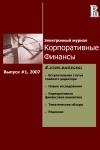The Impact of Efficiency Factors of High Tech Alliances on the Corporate Value: Indian and Chinese Evidence
Abstract
Authors: Elvina Rifhatovna Bayburina National Research University The Higher School of Economics
Ivan Ivanovich Rodionov - National Research University "Higher School of Economics." Email: irodionov@hse.ru
Hi-tech innovative alliances tend to have more key sustainable competitive advantages in comparison with those out of alliance, especially because alliances allow the companies to switch through the partners the financial burdens and intellectual investments in innovations. BRIC make an important input into Gross World Production and its hi-tech industries grow faster than others over developing countries.However companies of these industries still lack internal resources of innovative and technological facilities, e.g. Russian companies, because of that alliances (usually, international anв transnational) acquire more and more popularity.Alliances give the access towards resources and competences of the direct and indirect partners. The paper describes the empirical evidence of alliances efficiency factors and its influence on the high-tech companies of India and China. This evidence can be replicable to some extent and useful to the development of Russian companies. According to the testing results it is possible to assume, that efficiency of alliances has the significant impact on the corporate value in the mid-term. The crisis has significant impact on the observable dependencies.

